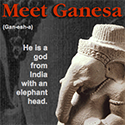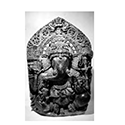|
|
| Show All 31 Results (Text Only) |
|
|
| Epic Literature – The Ramayana (Story of Rama) |
|
| Asian Art Museum of San Francisco
|
Students are introduced to the Ramayana (Story of Rama) and recall events by sequencing related art objects on a Story Hill. Then students make connections between artistic and literary depictions of character by comparing Vishnu and Ravana. Downloads include a lesson plan, multiple handouts, guides, and appendices, and a slideshow.
Go to Museum Resource: https://education.asianart.org/resources/epic-literature-the-ramayana-story-of-... | |
|
|
| Good and Evil? Dynamic Opposites in the Story of Rama |
|
| Asian Art Museum of San Francisco
|
Students brainstorm the qualities of good and evil and draw conclusions about the Balinese concept of “dynamic” or balanced opposites. Then, students will relate the idea of “dynamic opposites” in the Ramayana (Story of Rama) to present-day situations by identifying a current problem, creating a visual identify for their own pair of opposing characters, and scripting a dialogue. Downloads include lesson plans, activities, background and slideshow.
Go to Museum Resource: https://education.asianart.org/resources/good-and-evil-dynamic-opposites-in-the... | |
|
|
| How does Art Tell Stories? |
|
| Seattle Art Museum
|
Game about gods from India and Southeast Asia. See Ganesa dance, and discover why Vishnu changes into a boar and Buddha has a bump on his head. After learning about gods from India and Southeast Asia, use this guide for discussing the sculpture, Hinduism, Buddhism and for leading related activities. The unit theme links visual art with language arts, and in some activities with performing arts. Questions and discussion ideas, classroom activities, stories, glossary, and other resources are included. (Activities on Buddha, Vishnu, Hinduism and Buddhism.)
Go to Museum Resource: http://www1.seattleartmuseum.org/onlineActivities/ArtStories/ | |
|
|
|
| Indian Art: Puja and Piety [PDF] |
|
| Santa Barbara Museum of Art
|
In Puja and Piety, stone is one of the most universal materials used to make sculptures, shrines, and votives. It is part of Hindu belief that if a stone is shaped into a functional object, it becomes filled with a sacred essence and is used as part of puja (worship). Even stone unchanged by human hands can be held as sacred. In thousands of temples throughout India, svayambhu, a natural, uncarved stone, is the primary murti, or embodiment of the Divine. For over 2500 years, sculptors have been using stone as their medium. By knowing which stone would work best for their purposes, early artisans were able to create these enduring works of religious art.
Go to Museum Resource: https://content.sbma.net/education/lessonPlans/pdf/75Rock%20On-Janey%20Cohen-Hi... | |
|
|
| India: Shiva Nataraja (Lord of the Dance) |
|
| National Museum of Asian Art, Smithsonian Institution
|
"Nataraja is one of the most important, visually thrilling forms of the Hindu god Shiva... Ta-dum, ta-dum, ta-dum..." beats the drum in Nataraja's hand, as he shakes it, giving rhythm to his dancing feet and sound to his image. Shiva, the auspicious one, is manifest here as the Lord of the Dance, a form he has taken not to entertain but perform cosmic work. Shiva Nataraja is crushing ignorance, presented by the sculptor as a demon under his feet who looks up benevolently at the god, even as his own ruin is in progress..."
Go to Museum Resource: https://asia.si.edu/learn/india-shiva-nataraja-lord-of-the-dance/ | |
|
|
|
|
| Show All 31 Results (Text Only) |








